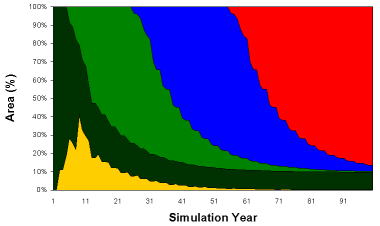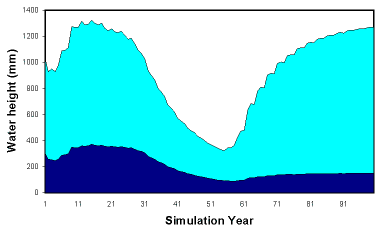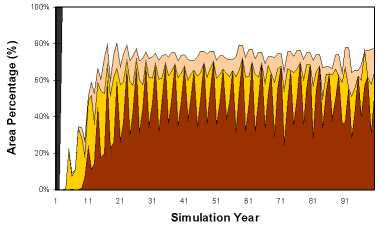

Example
on FALLOW application
Reconstruct historical pathway of land-use/cover change
In this example, simulation was initialized from totally forested landscape, which was occupied by 5 inhabitants/km2 of people who had a relatively adaptive learning style. Human population increased according to natural growth and migration that were determined by food sufficiency and returns to labour respectively. Shifting cultivation was the first livelihood recognised in the area, which fallow duration was affected directly by food need. Market had been introduced at this early stage. People then adopted coffee agroforestry and NTFP gathering activities as alternative livelihoods. Later, agroforestry development led to tenure recognition and land privatisation, through which people had the power to exchange their lands, which might lead to increase land-holding size to start adopting more modern type of production system, which was monoculture coffee plantation. In more profit-oriented type of people, market dynamics could trigger people to alter tree-based production systems into horticultural production systems, which was more promising in term of profit that could be earned in relatively shorter time. And the results of simulation for 100 years are:
Land-use/cover
change in space…
Land-use/cover
change in time…
Impact
on carrying capacity…
Impact
on watershed functions…
Impact
on biodiversity…
Impact on carbon stocks…
Cultivated
crop type as function of soil fertility…
Land-use/cover change in space…
 Initial cropping activities in year-3 (orange cells) |
 Initial agroforestry development in year-6 (banana yellow cells) |
 Initial coffee monoculture development in year-26 (blue cells) |
 Initial horticulture development in year-56 (light grey cells) |
back
to top
Land-use/cover
change in time…

Simulated
land-use/cover change for 1 century period. Yellow is cropped fields,
dark green is forested area, green is agroforest, blue is coffee monoculture,
and red is horticulture. Remaining forested area was protected forests.
back
to top
Impact
on carrying capacity…

In
term of food sufficiency¸ carrying capacity of the landscape crashed
at the population density of about 154 inhabitants/km2 around year-25.
In term of returns to labour, attractiveness of the landscape crashed
when people started to adopt horticultural system around year-56, since
such system exploited soil fertility at relatively high degree.
back
to top
Impact
on watershed functions…

Due
to relatively higher water use, agroforestry and plantation types of vegetations
yielded lower water yield (cyan) compared to horticulture, while those
two tree-based production systems could maintain soil physical properties,
so that they could result relatively higher baseflow (dark blue).
back
to top
Another
impact on watershed functions…

In
term of sediment loss, tree-based production systems of agroforestry and
plantation could decrease sediment loss.
back
to top
Since
the development of monoculture plantations, either plot-level biodiversity
(light green) or landscape-level biodiversity (green) decreased. Remaining
forest reserve could maintain biodiversity level.
back to top

Triggered by coffee monoculture booming, carbon stocks of the landscape declined mainly due to land-clearing and dynamic land conversion. Increase was caused by remaining forest reserve.
back to top
Cultivated
crop type as function of soil fertility…

As
preference on the type of cultivated crops reflected on how people adapted
to changing soil fertility, cassava (red brown) dominated cropping area
when soil fertility declined, since cassava has wider range adaptability
to soil fertility. Initially, people preferred to cultivate rice (white).
Yellow is maize, light brown is groundnut.
back to top
